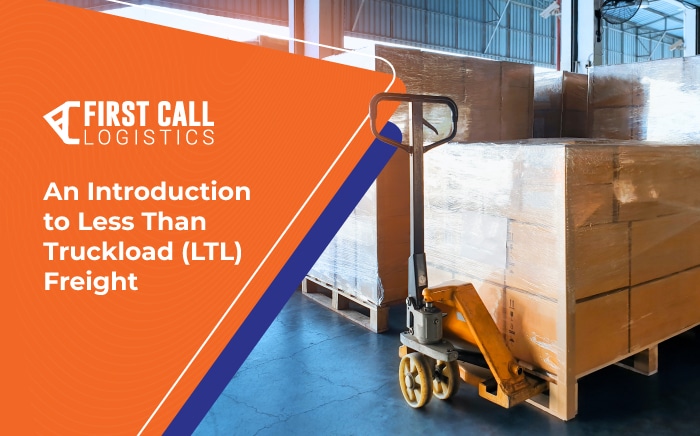An Introduction to Less Than Truckload (LTL) Freight

The world of transportation logistics is all about optimizing loads to save time and money. What do businesses do when their shipments don’t fill a full truckload? Less than truckload (LTL) freight provides a convenient solution that saves shippers money.
What is LTL Freight?
Less than truckload freight is a method of transporting small goods that don’t require a full truckload. Because products are packaged in smaller parcels, many separate shipments may be transported in one truck. LTL carriers optimize trailer space while serving multiple customers at once.
Although less than truckload freight is considered small by shipping industry standards, the shipments can range from 150 pounds to 15,000 pounds. The postal service and similar entities can’t transport shipments above 150 pounds. LTL carriers offer a practical solution to shippers whose products are too big for the postal service but not large enough for a full truckload.
Typically, less than truckload freight shipments are sent through third-party logistics companies (3PLs). 3PLs are able to move more goods efficiently because they can fit multiple shipments onto one truck. less than truckload shipments are arranged on pallets and stacked to best protect the products. This is more cost effective and environmentally friendly due to the savings in fuel.
As the name implies, less than truckload freight is different from full truckload (FTL) in that multiple smaller shipments can fit onto one truck. The biggest difference for shippers comes in with cost savings associated with LTL. Shipping a few pallets at a time is cheaper because you only pay for the space you use rather than paying for a full truck that isn’t filled to capacity. less than truckload carriers maximize their efficiency by filling the remaining space with other shipments. In this way, both customers and LTL carriers benefit from this method of transportation.
When LTL Freight Can Work for You
Since shippers use less than truckload freight any time they’re transporting more than 150 pounds but less than a full truckload, there are infinite ways to benefit from LTL freight.
Price and efficiency are two areas where less than truckload exceeds other options. Because multiple shippers share a trailer, LTL carriers can optimize multi-stop delivery routes. This saves time and uses less fuel than if each shipper used its own truck.
While fuel savings are a big incentive to use less than truckload freight, there are other monetary savings associated with LTL. The expenses of labor and upkeep for a fleet of trucks add up quickly. less than truckload freight eliminates the need for companies to bear the full burdens of those costs.
Technology and equipment that are used for less than truckload freight provide more benefits. With various platforms, shipments can be tracked in real-time from start to finish by shippers and their customers. LTL carriers also have access to equipment such as temperature-controlled trailers and liftgates. A liftgate is used to unload shipments of over 100 pounds when a location doesn’t have a loading dock.
In addition to granting access to technologies and equipment, less than truckload freight provides shippers with security. They have the advantages of professional shipping without taking on excessive costs for labor, equipment, and space. LTL freight keeps pallets and parcels together, decreasing the chances of damage. This saves money and increases customer satisfaction.
Considerations for LTL Freight
While less than truckload freight is an exciting opportunity for many businesses, it’s important to consider several factors in choosing the right LTL carrier.
The first thing to consider is your commodity. Does the product require special conditions, such as temperature-controlled shipping? Make sure your LTL carrier can accommodate these needs to maintain the integrity of your product.
Knowing your shipment’s freight class will also help you in sorting through less-than-truckload carriers because it will factor into pricing. Freight class is determined by calculating freight density. To do this, you need to know the dimensions of your freight as well as its weight. The weight in pounds divided by the cubic feet gives you the density. LTL carriers use this information for utilization purposes. The smaller and heavier the freight, the better it can be utilized and vice versa. Costs go up with less dense freight so that will be a major factor in determining costs.
Less than truckload freight provides many advantages, but shippers should work closely with carriers to understand how this method of shipping will affect their timelines. Since trucks contain shipments from multiple clients, they typically also have multiple destinations. This is why having a transportation management system (TMS) is critical. Businesses using LTL should budget sufficient time for freight to arrive at their destinations.
As with other types of transportation, less than truckload freight is affected by seasonal changes in demand. Each spring, freight shipping increases, leading to fewer available trucks and drivers. Businesses should ship LTL freight as early as possible to allow for these seasonal changes.
Less than truckload freight provides shippers with a cost-saving option to securely transport goods. By carrying multiple shipments in one load, LTL carriers can serve several shippers on multi-stop routes.
Learn how First Call Logistics’ various LTL services can work for your business. Reach out to First Call Logistics today!
Simplify your Next Shipment with First Call Logistics
Building and managing cost-efficient supply chains is a full-time job. First Call’s rare combination of in-house assets, expert problem-solving and track record of stellar customer service makes us the 3PL of choice for business partners with a wide range of shipping needs.